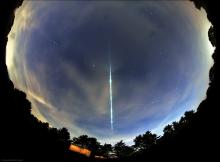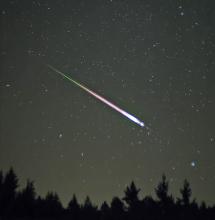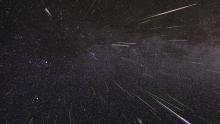Listen to today's episode of StarDate on the web the same day it airs in high-quality streaming audio without any extra ads or announcements. Choose a $8 one-month pass, or listen every day for a year for just $30.
You are here
Lyrid Meteors
A modest meteor shower should be at its best tonight. You need dark skies to see it — the glow of city lights will erase it from view. And even at its peak, the shower produces no more than a dozen or so meteors per hour. But the Moon won’t get in the way, so if you have good weather and a good viewing spot, it’s worth a look.
The Lyrid shower occurs at this time every year as Earth passes through a trail of comet dust — debris from Comet Thatcher.
The comet last visited the inner solar system in 1861, and it won’t return for almost three centuries. But each time it approaches the Sun, it sloughs off bits of rock and dirt. Over time, these particles spread out along the comet’s orbital path. When Earth flies through that path, some of the grains of material slam into our planet’s atmosphere at tens of thousands of miles per hour. They quickly vaporize, forming the glowing streaks of light known as meteors.
The shower is named for the constellation Lyra, the harp. That’s because its meteors all appear to “rain” into the sky from near Vega, Lyra’s brightest star. They can fly across any part of the sky, though, so you don’t need to be looking at Lyra to see them.
The best view comes after Lyra climbs into good view, after midnight. The Moon sets a little later, making the skies nice and dark. That will provide several good hours to watch the meteors — reminders of a comet that’s billions of miles from Earth.
Script by Damond Benningfield






